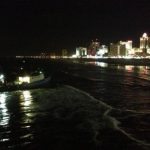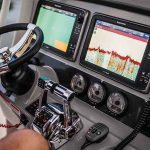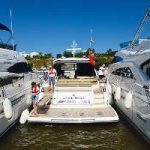When anticipating meeting another boat’s wake, seat all passengers aft or amidships, away from the bow. Most serious injuries are to those seated near the bow.
Be sure and warn everybody on board when approaching another boat’s wake. Passenger who are unaware of the impending shock of a wake may be thrown into windshields or other fixtures on the boat, may fall, or may be thrown overboard.
Nearly all wake injuries are the result of passengers standing in the boat. The skipper should issue firm instructions that passengers should be SEATED when approaching a wake. This is especially important to the passengers that may be below, and therefore unable to see the danger and prepare for it.
Slow the boat BEFORE the wake arrives. Don’t wait until you’re in the middle of the wake pattern before pulling back on the throttle.
Don’t bring your boat to a complete stop. Maintain some headway, so the bow doesn’t get shoved aside.
When overtaking another boat, cross the wake quickly rather than riding the waves. The force of a wake on either side of the hull can cause loss of control and maneuverability, and the longer you stay on the wave, the greater the chance of that happening.
Try and avoid taking a steep wake on the beam. You should change course briefly into the wake, and then proceed back to your course after clearing the wake.
Operating an overloaded boat is always dangerous, but the danger is many times greater in areas where there is heavy boat traffic and large wakes. Never overload your boat. Adhere to the limits on your capacity plate.
Anchor in protected areas. Wakes from passng boats can cause falls, galley accidents, and even structural damage.
Shallow water increases the height of your boat’s wake. Always look behind you when increasing or decreasing throttle, so you are aware of your wakes impact.
Your speed and your trim determine the size of your wake. Take time to know what kind of wake your boat throws under various trim and speed conditions.
If your boat is out of trim, or comes on plane slowly, you will throw a larger wake than expected. Make sure your boat is trimmed correctly, and bring the boat on plane as quickly and safely as possible.
Slow your boat in advance of your wake. If you intend to minimize your wake near a marina, small boat, etc., it is too late to reduce throttle when you are abeam of that objective.
REMEMBER…YOU ARE LEGALLY RESPONSIBLE FOR INJURIES OR DAMAGE RESULTING FROM YOUR WAKE!








